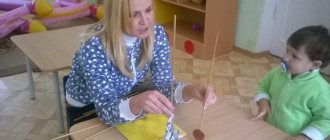MAGAZINE Preschooler.RF
Workshop “Speech development of preschool children in accordance with the Federal State Educational Standard for Education”Pirmagomedova Elmira Mirzaferovna Position: Educator Place of work: MBDOU Kindergarten No. 17 “Belochka” Surgut, Tyumen region, Khanty-Mansi Autonomous Okrug -Yugra
Goal: to create conditions for improving the professional competence of preschool teachers in the field of knowledge of the Federal State Educational Standard for Preschool Education.
Tasks:
- discuss the content of the educational field: the speech development of a child in the Federal State Educational Standard for Preschool Education
- improving the work of teachers on the speech development of preschool children
- to systematize teachers’ theoretical knowledge on the formation of coherent speech in preschoolers in a playful way, to develop their horizons
- develop in teachers the ability to use modern pedagogical technologies, game methods and techniques for developing the speech of preschool children
- increase the interest of teachers in the problem of speech formation in preschoolers.
Agenda.
1. Theoretical part:
- GEF DO: speech development.
- Relevance of the problem of speech development in preschool children.
2. Practical part:
- The use of game forms and methods, elements of modern pedagogical technologies aimed at developing the speech of preschool children.
- Games, fairy tales, noisemakers using socio-game technology.
- Health-saving technologies (sand therapy, finger games with water).
- Scheme games for the development of coherent speech.
- TRIZ game exercises.
- Methods and techniques of technology Fesyukova L.B. "Education with a fairy tale" .
- Video “Articulation gymnastics”
- The use of ICT in the correctional and educational process of preschool educational institutions.
- Draft decision.
Move
Game exercise for teachers “My expectations today” .
Theoretical part
Relevance of the problem of speech development in preschool children. GEF DO: speech development.
Relevance. Almost everyone can speak, but only a few of us can speak correctly. When talking with others, we use speech as a means of conveying our thoughts. Speech is one of the main human needs and functions for us. It is through communication with other people that a person realizes himself as an individual.
It is impossible to judge the beginning of the personality development of a preschool child without assessing his speech development. In the mental development of a child, speech is of exceptional importance. The development of speech is associated with the formation of both the personality as a whole and all mental processes. Therefore, determining the directions and conditions for the development of speech in children are among the most important pedagogical tasks. The problem of speech development is one of the most pressing.
Reasons for low level of speech development:
- Half of preschool children have insufficiently developed skills in constructing a coherent statement. Based on the results of the analysis of observations in groups, the following disadvantages can be noted:
- coherent statements are short;
- are characterized by inconsistency, even if the child conveys the content of a familiar text;
- consist of separate fragments that are logically unrelated to each other;
- the level of information content of the statement is very low.
In addition, most children actively share their impressions of the events they experienced, but are reluctant to begin writing stories on a given topic. Basically, this happens not because the child’s knowledge on this issue is insufficient, but because he cannot formulate it into coherent speech statements.
When conducting a lesson, the teacher sees himself and the techniques, but does not see the child, i.e. In class, we sometimes observe what one teacher says.
- Insufficient preparation for the lesson. When looking at a picture or having a conversation, you need to carefully think through the questions.
- The teacher’s speech culture also plays a very important role in the development of speech. Staff give children examples of correct literary speech: the teacher’s speech should be clear, clear, complete, and grammatically correct; speech should include a variety of speech etiquette examples.
- Parents do not understand their function - communication with the child should begin from birth and before his birth, in the perinatal period.
The concept of coherent speech and its importance for the development of a child.
Coherent speech is understood as a semantically expanded statement (a series of logically combined sentences) that ensures communication and mutual understanding. Connectivity, believed S.L. Rubinstein, this is “the adequacy of the verbal presentation of the speaker’s or writer’s thoughts from the point of view of its intelligibility for the listener or reader . Consequently, the main characteristic of coherent speech is its intelligibility for the interlocutor.
Coherent speech is a speech that reflects all the essential aspects of its subject content.
In the methodology, the term “coherent speech” is used in several meanings: 1) process, activity of the speaker; 2) product, the result of this activity, text, statement; 3) the title of the section of work on speech development. “statement” and “text” are used synonymously . An utterance is both a speech activity and the result of this activity: a specific speech product, greater than a sentence. Its core is meaning (T. A. Ladyzhenskaya, M. R. Lvov, etc.).
The main function of coherent speech is communicative. It is carried out in two main forms - dialogue and monologue. Each of these forms has its own characteristics, which determine the nature of the methodology for their formation.
Dialogical speech is a particularly striking manifestation of the communicative function of language. Scientists call dialogue the primary natural form of linguistic communication, the classical form of verbal communication. The main feature of the dialogue is the alternation of speaking by one interlocutor with listening and subsequent speaking by the other.
Monologue speech is a coherent, logically consistent utterance that lasts a relatively long time and is not designed for an immediate reaction from listeners. It has an incomparably more complex structure and expresses the thought of one person, which is unknown to the listeners. Therefore, the statement contains a more complete formulation of information, it is more detailed. A monologue requires internal preparation, longer preliminary thinking about the statement, and concentration of thought on the main thing. Here, too, non-verbal means (gestures, facial expressions, intonation), the ability to speak emotionally, vividly, and expressively are important, but they occupy a subordinate place. The monologue is characterized by: literary vocabulary; expansion of the statement, completeness, logical completeness; syntactic design (extensive system of connecting elements); the coherence of the monologue is ensured by one speaker.
These two forms of speech also differ in motives. Monologue speech is stimulated by internal motives, and its content and linguistic means are chosen by the speaker himself. Dialogical speech is stimulated not only by internal, but also by external motives (the situation in which the dialogue takes place, the interlocutor’s remarks).
Consequently, monologue speech is a more complex, arbitrary, more organized type of speech and therefore requires special speech education.
It is obvious that the skills and abilities of dialogical speech are the basis for mastering a monologue. In the course of teaching dialogical speech, the prerequisites are created for mastering narration and description. This is also helped by the coherence of the dialogue: the sequence of remarks determined by the topic of the conversation, the logical and semantic connection of individual statements with each other. In early childhood, the formation of dialogic speech precedes the formation of monologue, and in the future, work on the development of these two forms of speech proceeds in parallel.
The development of both forms of coherent speech plays a leading role in the process of the child’s speech development and occupies a central place in the overall system of work on speech development in kindergarten. Teaching coherent speech can be considered both as a goal and as a means of practical language acquisition. Mastering different aspects of speech is a necessary condition for the development of coherent speech, and at the same time, the development of coherent speech contributes to the child’s independent use of individual words and syntactic structures. Coherent speech absorbs all the child’s achievements in mastering his native language, its sound structure, vocabulary, and grammatical structure.
Psychologists emphasize that in coherent speech the close connection between the speech and mental education of children is clearly evident. A child learns to think by learning to speak, but he also improves speech by learning to think (F. A. Sokhin).
Coherent speech performs the most important social functions: it helps the child establish connections with people around him, determines and regulates the norms of behavior in society, which is a decisive condition for the development of his personality.
Teaching coherent speech also has an impact on aesthetic education: retellings of literary works and independent children’s compositions develop imagery and expressiveness of speech, enriching children’s artistic and speech experience.
The concept of standard. Analysis with teachers of the concept of “standard” . The Federal State Educational Standard for Preschool Education reflects agreed upon socio-cultural, public and state expectations regarding the level of preschool education, which are guidelines for the founders of preschool organizations, specialists in the education system, and families of pupils.
Federal State Educational Standards for preschool education: speech development (on the slide there is a comparison of Federal State Educational Standards and FGT)
Contents of the educational field of speech development:
- mastery of speech as a means of communication and culture
- enrichment of the active dictionary
- development of coherent, grammatically correct dialogical and monologue speech
- development of speech creativity
- development of sound and intonation culture of speech, phonemic hearing
- acquaintance with book culture, children's literature, listening comprehension of texts of various genres of children's literature
- formation of sound analytical-synthetic activity as a prerequisite for learning to read and write.
Key tasks of updating the educational process:
- Fill your child's life with interesting content.
- Creative approach to content selection based on integration, using a variety of methods and techniques.
- Wide inclusion in the educational process of a variety of games, gaming techniques and gaming situations.
- Variability in the selection of topics, forms, means, methods (novelty and diversity).
- Elimination of formalism, stereotypes, and excessive didacticism.
- Attentive, tactful attitude towards the child and his capabilities.
Practical part
Speech by teachers: the use of game forms and methods, modern pedagogical technologies aimed at developing the speech of preschoolers.
- Games, fairy tales, noisemakers using socio-game technology.
- Health-saving technologies (sand therapy, finger games with water).
- Scheme games for the development of coherent speech.
- TRIZ game exercises.
- Methods and techniques of technology Fesyukova L.B. "Education with a fairy tale" .
- Video “Articulation gymnastics”
- The use of ICT in the correctional and educational process of preschool educational institutions.
Literature
- Alekseeva M.M., Yashina B.I. Methods of speech development and teaching the native language of preschoolers: Proc. aid for students higher and Wednesday ped. textbook head – M.: “Academy” , 2000. – 400 p.
- Belaya K.Yu. Methodological work in preschool educational institutions: Analysis, planning. Forms and methods. – M., 2010. – 96 p.
- Kopytova N.N. Organization of methodological work of the senior teacher with the teaching staff of the preschool educational institution. – St. Petersburg, 2008. – 96 p.
| Next > |
Workshop for educators Topic: “Formation of coherent speech in preschoolers”
3. Task for middle-aged children
(Improve the dialogic form of speech. Develop the monologue form of speech.
Learn to retell short tales and stories coherently, consistently and expressively.
Teach (according to a plan and model) to talk about the subject, the content of the plot picture, to compose a story based on pictures with a sequentially developing action.
Develop the ability to compose stories about events from personal experience, come up with your own endings to fairy tales.);
4. Challenge for older children
(Teach to retell short tales and stories coherently, consistently and expressively.
Teach (according to a plan and model) to talk about the subject, the content of the plot picture, to compose a story based on pictures with a sequentially developing action.
Develop the ability to compose stories about events from personal experience, come up with your own endings to fairy tales.);
5.Task for young children
(Involve children in conversation while looking at objects, paintings, illustrations; observing living objects; after watching plays, cartoons. Teach the ability to conduct a dialogue with the teacher and peers: listen and understand the question asked, answer it clearly, speak at a normal pace, without interrupting the speaker.);
6.A task for children in the pre-school group.
(Continue to teach meaningful and expressive retelling of literary texts, dramatizing them.
Improve the ability to compose stories about objects, about the content of a picture, based on a set of pictures with a sequentially developing action. Help create a story plan and stick to it.)
Let's remember the main types of storytelling and the methodology for conducting basic educational activities.
- storytelling based on a toy; – retelling of literary works; – a story based on a painting and a series of narrative paintings; – stories from children’s personal experiences; - creative stories.
I suggest you watch the presentations of your colleagues.
We have looked at modern technologies for speech development, now we will look at innovative ones.
View the presentation “The use of modern educational technologies in the development of speech of preschool children in the conditions of the Federal State Educational Standard for Education.”
Practical task (work in 3 subgroups)
1st subgroup - write a story about a toy for the younger group; 2nd subgroup - compose a story based on the plot picture for the middle group; 3rd subgroup - compose a story based on a series of plot pictures for the senior/pre-graduate group.
Discussion, exchange of opinions, holding the results of the event.
Bibliography:
1. Arushanova A.G.
“Speech and verbal communication of children 3-7 years old” 2.
Alyabyeva E.A.
“Development of imagination and speech of children 4-7 years old” 3.
Vanyukhina G.A.
“Features of the organization of lexical and grammatical games in the structure of the semantic field” 4.
Grizik I.V.
“Teaching children to describe objects” 5.
Konina M.M.
“The role of pictures in teaching the native language to children of senior preschool age” 6.
Korotkova E.P.
“Conversation as a means of speech development in preschool children” 7.
Ushakova O.S.
“Teaching storytelling to older preschoolers using a series of plot pictures” 8.
Ushakova O.S.
“Methodology for the development of speech in preschool children” 9.
Shchipitsyna
“The ABC of Communication”
Publication address:





